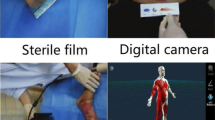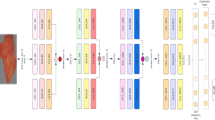Abstract
Accurate assessment and classification of burn severity have gained research interest in burn management, and delays in treatment increase the risk of human lives. Many research techniques are attempted earlier that examine the burn features and determine the depth of injuries. However, the differences like shape, color, appearance, and area lead to inaccurate separation of healthy and burn portions. At the end, we propose a Dense Mesh Region Convolutional Neural Network (RCNN) model for burn region segmentation and improving the calculation of total burn surface area (TBSA). The main objective is the precise quad mesh prediction that gives the full 3D human shape representation and models fine structures of each detected object from a diverse, real-world environment. In this model, we have introduced the shape alignment module preserves the feature correspondence between the predicted voxels and input in detecting exact instance-specific shapes and poses. Also, for the detection of smaller subjects, a 3D Scale-Aware Residual Dilated Pyramidal Pooling Module (3D-SRDPPM) is adopted that benefits complex scenes. Further, the quad mesh generation from the voxelated grids can be applied for the full 3D mesh for each object. In the training stage, different loss functions are estimated to overcome the losses across each stage in segmenting different levels of burns. Experimental analysis is conducted with various metrics, and their performance is examined with existing techniques. The proposed method achieves improved segmentation results with high accuracy (94.1%), precision (95.9%), recall (94.8%), and F1-score (95.3%).





Similar content being viewed by others
References
Zhai LN, Li J (2015) Prediction methods of skin burn for performance evaluation of thermal protective clothing. Burns 41(7):1385–1396
Haller HL, Giretzlehner M, Dirnberger J, Owen R (2012) Medical documentation of burn injuries. Handbook of burns. Springer, Vienna, pp 117–129
Torpy JM, Lynm C, Glass RM (2009) Burn injuries. JAMA 302(16):1828–1828
Rowland RA, Ponticorvo A, Baldado ML, Kennedy GT, Burmeister DM, Christy RJ, Durkin AJ (2019) Burn wound classification model using spatial frequency-domain imaging and machine learning. J Biomed Opt 24(5):056007
Serrano C, Boloix-Tortosa R, Gómez-Cía T, Acha B (2015) Features identification for automatic burn classification. Burns 41(8):1883–1890
Zafar K, Gilani SO, Waris A, Ahmed A, Jamil M, Khan MN, SohailKashif A (2020) Skin lesion segmentation from dermoscopic images using convolutional neural network. Sensors 20(6):1601
Tran H, Le T, Le T, Nguyen T (2015) Burn image classification using one-class support vector machine. In: ICCASA, pp 233–242
Yadav DP (2021) A method for human burn diagnosis using machine learning and SLIC superpixels based segmentation. In: IOP Conference Series: Materials Science and Engineering, vol 1116. IOP Publishing, pp 012186
Bhansali RM, Kumar R (2021) BurnNet: an efficient deep learning framework for accurate dermal burn classification. medRxiv
Jaskille AD, Shupp JW, Jordan MH, Jeng JC (2009) Critical review of burn depth assessment techniques: part I. Historical review. J Burn Care Res 30(6):937–947
Pinero BA, Serrano C, Acha JI, Roa LM (2005) Segmentation and classification of burn images by color and texture information. J Biomed Opt 10(3):034014
Abdolahnejad M, Lee J, Chan H, Morzycki A, Ethier O, Mo A, Liu PX, Wong JN, Hong C, Joshi R (2023) Boundary attention map** (BAM): fine-grained saliency maps for segmentation of burn injuries. ar**v preprint ar**v:2305.15365
Boissin C, Laflamme L, Fransén J, Lundin M, Huss F, Wallis L, Allorto N, Lundin J (2023) Development and evaluation of deep learning algorithms for assessment of acute burns and the need for surgery. Sci Rep 13(1):1794
Tran HS, Le TH, Nguyen TT (2016) The degree of skin burns images recognition using convolutional neural network. Indian J Sci Technol 9(45):1–6
Hai TS, Triet LM, Thai LH, Thuy NT (2017) Real-time burning image classification using support vector machine. EAI Endorsed Trans Context Aware Syst Appl 4(12):e4. https://doi.org/10.4108/eai.6-7-2017.152760
Despo O, Yeung S, Jopling J, Pridgen B, Sheckter C, Silberstein S, Milstein A (2017) BURNED: towards efficient and accurate burn prognosis using deep learning
Rangel-Olvera B, Rosas-Romero R (2021) Detection and classification of burnt skin on images with sparse representation of image patches and dictionaries. Technol Sci Cult A Glob Vis IV:121
Acha B, Serrano C, Fondón I, Gómez-Cía T (2013) Burn depth analysis using multidimensional scaling applied to psychophysical experiment data. IEEE Trans Med Imaging 32(6):1111–1120
Ethier O, Chan HO, Abdolahnejad M, Morzycki A, Tchango AF, Joshi R, Wong JN, Hong C (2022) Using computer vision and artificial intelligence to track the healing of severe burns. medRxiv. 2022–12
Gkioxari G, Malik J, Johnson J (2019) Mesh r-cnn. In: Proceedings of the IEEE/CVF International Conference on Computer Vision, pp 9785–9795
Karthik J, Nath GS, Veena A (2021) Deep learning-based approach for skin burn detection with multi-level classification. In: Advances in Computing and Network Communications: Proceedings of CoCoNet 2020, vol 2. Springer, Singapore, pp 31–40
Sinha A, Kawahara J, Pakzad A, Abhishek K, Ruthven M, Ghorbel E, Kacem A, Aouada D, Hamarneh G (2023) DermSynth3D: synthesis of in-the-wild annotated dermatology images. ar**v preprint ar**v:2305.12621
Gao T, Liu S, Gao E, Wang A, Tang X, Fan Y (2022) Automatic segmentation of laser-induced injury OCT images based on a deep neural network model. Int J Mol Sci 23(19):11079
Schenkenfelder B, Kaltenleithner S, Sabrowsky-Hirsch B, Klug C, Lumenta DB, Scharinger J (2022) Synthesizing diagnostic burn images for deep learning applications. In: 2022 Annual Modeling and Simulation Conference (ANNSIM), IEEE, pp 270–281
Cirillo MD, Mirdell R, Sjöberg F, Pham TD (2021) Improving burn depth assessment for pediatric scalds by AI based on semantic segmentation of polarized light photography images. Burns 47(7):1586–1593
Suha SA, Sanam TF (2022) A deep convolutional neural network-based approach for detecting burn severity from skin burn images. IEEE Access 10:171885–171896
Lee S, Rahul R, Lukan J, Boyko T, Zelenova K, Makled B, Parsey C, Norfleet J, De S (2022) A deep learning model for burn depth classification using ultrasound imaging. ar**v preprint ar**v:2203.15879
Chang CW, Ho CY, Lai F, Christian M, Huang SC, Chang DH, Chen YS (2023) Application of multiple deep learning models for automatic burn wound assessment. Burns 49(5):1039–1051
Liang J, Li R, Wang C, Zhang R, Yue K, Li W, Li Y (2022) A spiking neural network based on retinal ganglion cells for automatic burn image segmentation. Entropy 24(11):1526
Rambhatla S, Huang S, Trinh L, Zhang M, Long B, Dong M, Unadkat V, Yenikomshian HA, Gillenwater J, Liu Y (2022) DL4Burn: burn surgical candidacy prediction using multimodal deep learning. PLoS Med 19(2):e1003964
Zhang R, Tian D, Xu D, Qian W, Yao Y (2022) A survey of wound image analysis using deep learning: classification, detection, and segmentation. IEEE Access 10:9843957
Lee S, Rahul R, Ye H, Chittajallu D, Kruger U, Boyko T, Lukan JK, Enquobahrie A, Norfleet J, De S (2022) Real-time burn classification using ultrasound imaging. Sci Rep 12(1):9623
Li Z, Huang J, Tong X, Zhang C, Lu J, Zhang W, Song A, Ji S (2023) GL-FusionNet: fusing global and local features to classify deep and superficial partial thickness burn. Math Biosci Eng 20(6):10153–10173
Lu J, Deegan AJ, Cheng Y, Liu T, Zheng Y, Mandell SP, Wang RK (2021) Application of OCT-derived attenuation coefficient in acute burn-damaged skin. Lasers Surg Med 53(9):1192–1200
Chang CW, Lai F, Christian M, Chen YC, Hsu C, Chen YS, Chang DH, Roan TL, Yu YC (2021) Deep learning–assisted burn wound diagnosis: diagnostic model development study. JMIR Med Inform 9(12):e22798
Yadav DP, Aljrees T, Kumar D, Kumar A, Singh KU, Singh T (2023) Spatial attention-based residual network for human burn identification and classification. Sci Rep 13(1):12516
Yadav DP, Sharma A, Singh M, Goyal A (2019) Feature extraction-based machine learning for human burn diagnosis from burn images. IEEE J Transl. Eng Health Med 7:1–7
Chauhan J, Goyal P (2021) Convolution neural network for effective burn region segmentation of color images. Burns 47(4):854–862
Chauhan J, Goyal P (2020) BPBSAM: body part-specific burn severity assessment model. Burns 46(6):1407–1423
Wang Y, Ke Z, He Z, Chen X, Zhang Y, **e P, Kai L (2020) Real-time burn depth assessment using artificial networks: a large-scale multicentre study. Burns 46(8):1829–1838
Abubakar A, Ugail H, Smith KM, Bukar AM, Elmahmudi A (2020) Burns depth assessment using deep learning features. J Med Biol Eng 40(6):923–933
Rostami B, Niezgoda J, Gopalakrishnan S, Yu Z (2021) Multiclass Burn wound image classification using deep convolutional neural networks. ar**v preprint ar**v:2103.01361
Pabitha C, Vanathi B (2021) Dense-mask RCNN: a hybrid model for skin burn image classification and severity grading. Neural Process Lett 53(1):319–337
Liu H, Yue K, Cheng S, Li W, Fu Z (2021) A framework for automatic burn image segmentation and burn depth diagnosis using deep learning. Comput Math Methods Med. https://doi.org/10.1155/2021/5514224
Dai F, Zhang D, Su K, **n N (2021) Burn images segmentation based on Burn-GAN. J Burn Care Res 42(4):755–762
Jiao C, Su K, **e W, Ye Z (2019) Burn image segmentation based on mask regions with convolutional neural network deep learning framework: more accurate and more convenient. Burns Trauma. https://doi.org/10.1186/s41038-018-0137-9
Abubakar A, Ajuji M, UsmanYahya I (2020) Comparison of deep transfer learning techniques in human skin burns discrimination. Appl Syst Innov 3(2):20
Funding
There is no funding for this study.
Author information
Authors and Affiliations
Contributions
All the authors have participated in writing the manuscript and have revised the final version. All authors read and approved the final manuscript. All authors contributed to the study conception and design. Material preparation, data collection, and analysis were performed by PC and VB. The first draft of the manuscript was written by PC, and all authors commented on previous versions of the manuscript. All authors read and approved the final manuscript. PC contributed to conceptualization, methodology, and writing—original draft preparation; PC and VB were involved in formal analysis and investigation; and VB contributed to writing—review and editing and supervision.
Corresponding author
Ethics declarations
Conflict of interest
Authors declare that they have no conflict of interest.
Ethical approval
This article does not contain any studies with human participants and/or animals performed by any of the authors.
Informed consent
There is no informed consent for this study.
Additional information
Publisher's Note
Springer Nature remains neutral with regard to jurisdictional claims in published maps and institutional affiliations.
Rights and permissions
Springer Nature or its licensor (e.g. a society or other partner) holds exclusive rights to this article under a publishing agreement with the author(s) or other rightsholder(s); author self-archiving of the accepted manuscript version of this article is solely governed by the terms of such publishing agreement and applicable law.
About this article
Cite this article
Pabitha, C., Vanathi, B. Dense Mesh RCNN: assessment of human skin burn and burn depth severity. J Supercomput 80, 1331–1362 (2024). https://doi.org/10.1007/s11227-023-05660-y
Accepted:
Published:
Issue Date:
DOI: https://doi.org/10.1007/s11227-023-05660-y




